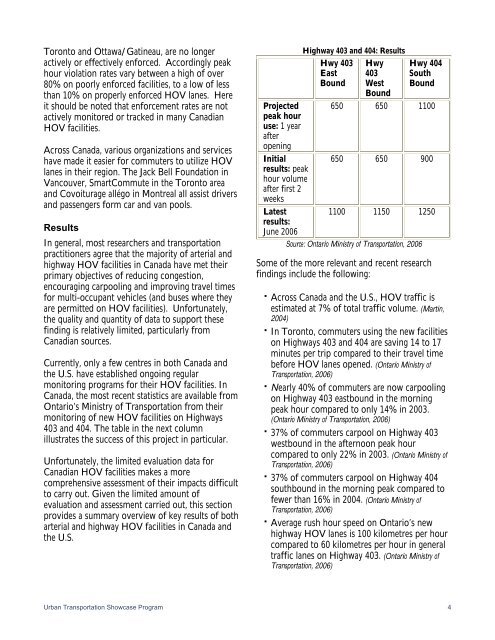High Occupancy Vehicle Lanes in Canada
High Occupancy Vehicle Lanes in Canada
High Occupancy Vehicle Lanes in Canada
Create successful ePaper yourself
Turn your PDF publications into a flip-book with our unique Google optimized e-Paper software.
Toronto and Ottawa/Gat<strong>in</strong>eau, are no longer<br />
actively or effectively enforced. Accord<strong>in</strong>gly peak<br />
hour violation rates vary between a high of over<br />
80% on poorly enforced facilities, to a low of less<br />
than 10% on properly enforced HOV lanes. Here<br />
it should be noted that enforcement rates are not<br />
actively monitored or tracked <strong>in</strong> many Canadian<br />
HOV facilities.<br />
Across <strong>Canada</strong>, various organizations and services<br />
have made it easier for commuters to utilize HOV<br />
lanes <strong>in</strong> their region. The Jack Bell Foundation <strong>in</strong><br />
Vancouver, SmartCommute <strong>in</strong> the Toronto area<br />
and Covoiturage allégo <strong>in</strong> Montreal all assist drivers<br />
and passengers form car and van pools.<br />
Results<br />
In general, most researchers and transportation<br />
practitioners agree that the majority of arterial and<br />
highway HOV facilities <strong>in</strong> <strong>Canada</strong> have met their<br />
primary objectives of reduc<strong>in</strong>g congestion,<br />
encourag<strong>in</strong>g carpool<strong>in</strong>g and improv<strong>in</strong>g travel times<br />
for multi-occupant vehicles (and buses where they<br />
are permitted on HOV facilities). Unfortunately,<br />
the quality and quantity of data to support these<br />
f<strong>in</strong>d<strong>in</strong>g is relatively limited, particularly from<br />
Canadian sources.<br />
Currently, only a few centres <strong>in</strong> both <strong>Canada</strong> and<br />
the U.S. have established ongo<strong>in</strong>g regular<br />
monitor<strong>in</strong>g programs for their HOV facilities. In<br />
<strong>Canada</strong>, the most recent statistics are available from<br />
Ontario’s M<strong>in</strong>istry of Transportation from their<br />
monitor<strong>in</strong>g of new HOV facilities on <strong>High</strong>ways<br />
403 and 404. The table <strong>in</strong> the next column<br />
illustrates the success of this project <strong>in</strong> particular.<br />
Unfortunately, the limited evaluation data for<br />
Canadian HOV facilities makes a more<br />
comprehensive assessment of their impacts difficult<br />
to carry out. Given the limited amount of<br />
evaluation and assessment carried out, this section<br />
provides a summary overview of key results of both<br />
arterial and highway HOV facilities <strong>in</strong> <strong>Canada</strong> and<br />
the U.S.<br />
Projected<br />
peak hour<br />
use: 1 year<br />
after<br />
open<strong>in</strong>g<br />
Initial<br />
results: peak<br />
hour volume<br />
after first 2<br />
weeks<br />
Latest<br />
results:<br />
June 2006<br />
<strong>High</strong>way 403 and 404: Results<br />
Hwy 403<br />
East<br />
Bound<br />
Hwy<br />
403<br />
West<br />
Bound<br />
Hwy 404<br />
South<br />
Bound<br />
650 650 1100<br />
650 650 900<br />
1100 1150 1250<br />
Source: Ontario M<strong>in</strong>istry of Transportation, 2006<br />
Some of the more relevant and recent research<br />
f<strong>in</strong>d<strong>in</strong>gs <strong>in</strong>clude the follow<strong>in</strong>g:<br />
• Across <strong>Canada</strong> and the U.S., HOV traffic is<br />
estimated at 7% of total traffic volume. (Mart<strong>in</strong>,<br />
2004)<br />
• In Toronto, commuters us<strong>in</strong>g the new facilities<br />
on <strong>High</strong>ways 403 and 404 are sav<strong>in</strong>g 14 to 17<br />
m<strong>in</strong>utes per trip compared to their travel time<br />
before HOV lanes opened. (Ontario M<strong>in</strong>istry of<br />
Transportation, 2006)<br />
• Nearly 40% of commuters are now carpool<strong>in</strong>g<br />
on <strong>High</strong>way 403 eastbound <strong>in</strong> the morn<strong>in</strong>g<br />
peak hour compared to only 14% <strong>in</strong> 2003.<br />
(Ontario M<strong>in</strong>istry of Transportation, 2006)<br />
• 37% of commuters carpool on <strong>High</strong>way 403<br />
westbound <strong>in</strong> the afternoon peak hour<br />
compared to only 22% <strong>in</strong> 2003. (Ontario M<strong>in</strong>istry of<br />
Transportation, 2006)<br />
• 37% of commuters carpool on <strong>High</strong>way 404<br />
southbound <strong>in</strong> the morn<strong>in</strong>g peak compared to<br />
fewer than 16% <strong>in</strong> 2004. (Ontario M<strong>in</strong>istry of<br />
Transportation, 2006)<br />
• Average rush hour speed on Ontario’s new<br />
highway HOV lanes is 100 kilometres per hour<br />
compared to 60 kilometres per hour <strong>in</strong> general<br />
traffic lanes on <strong>High</strong>way 403. (Ontario M<strong>in</strong>istry of<br />
Transportation, 2006)<br />
Urban Transportation Showcase Program 4
















